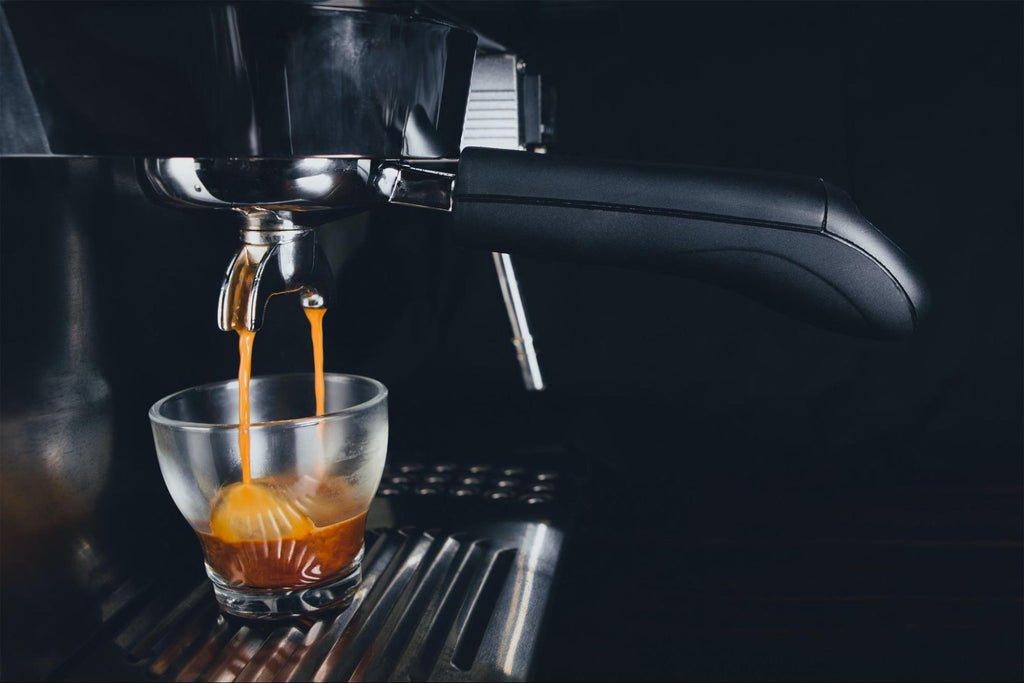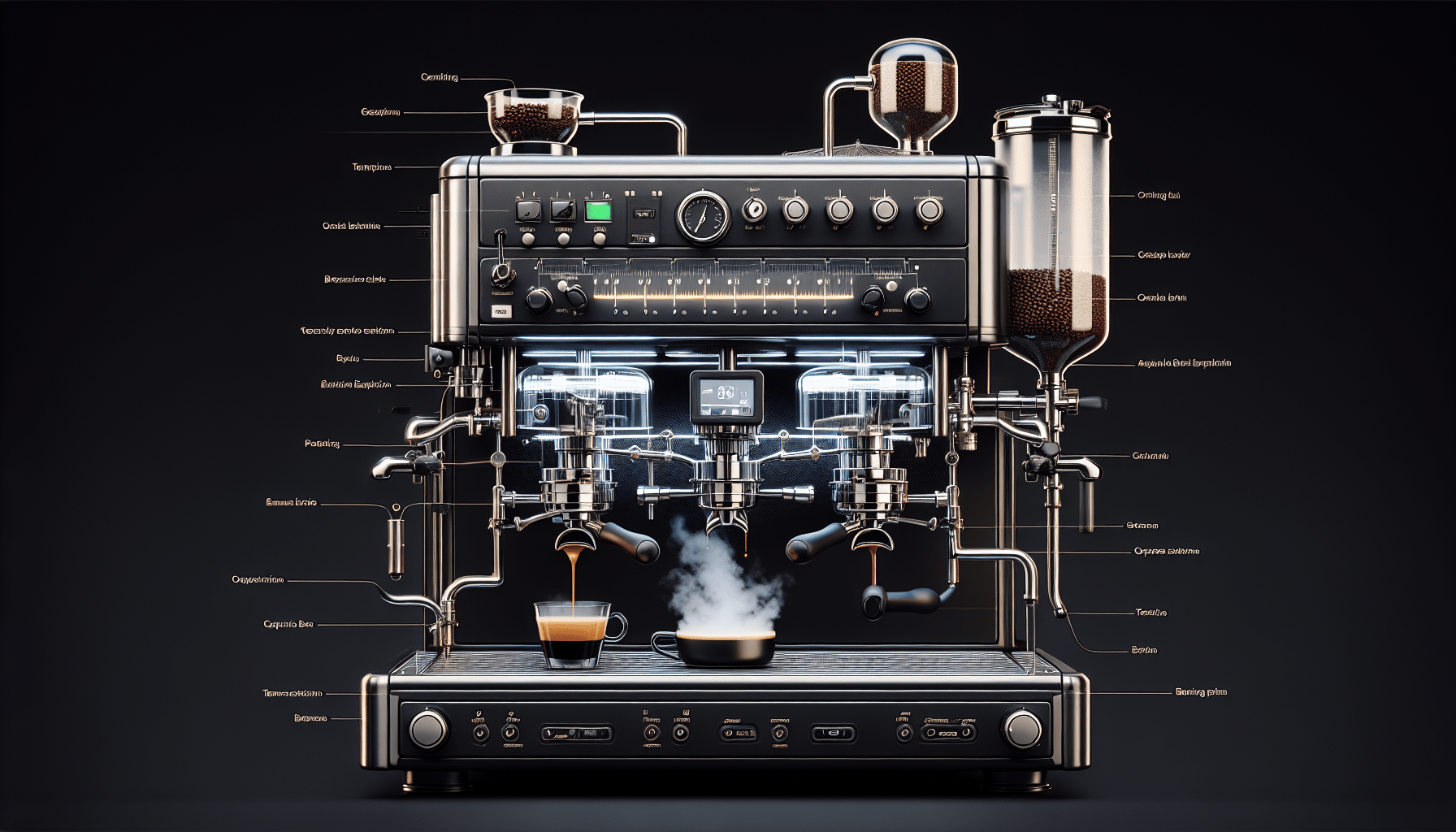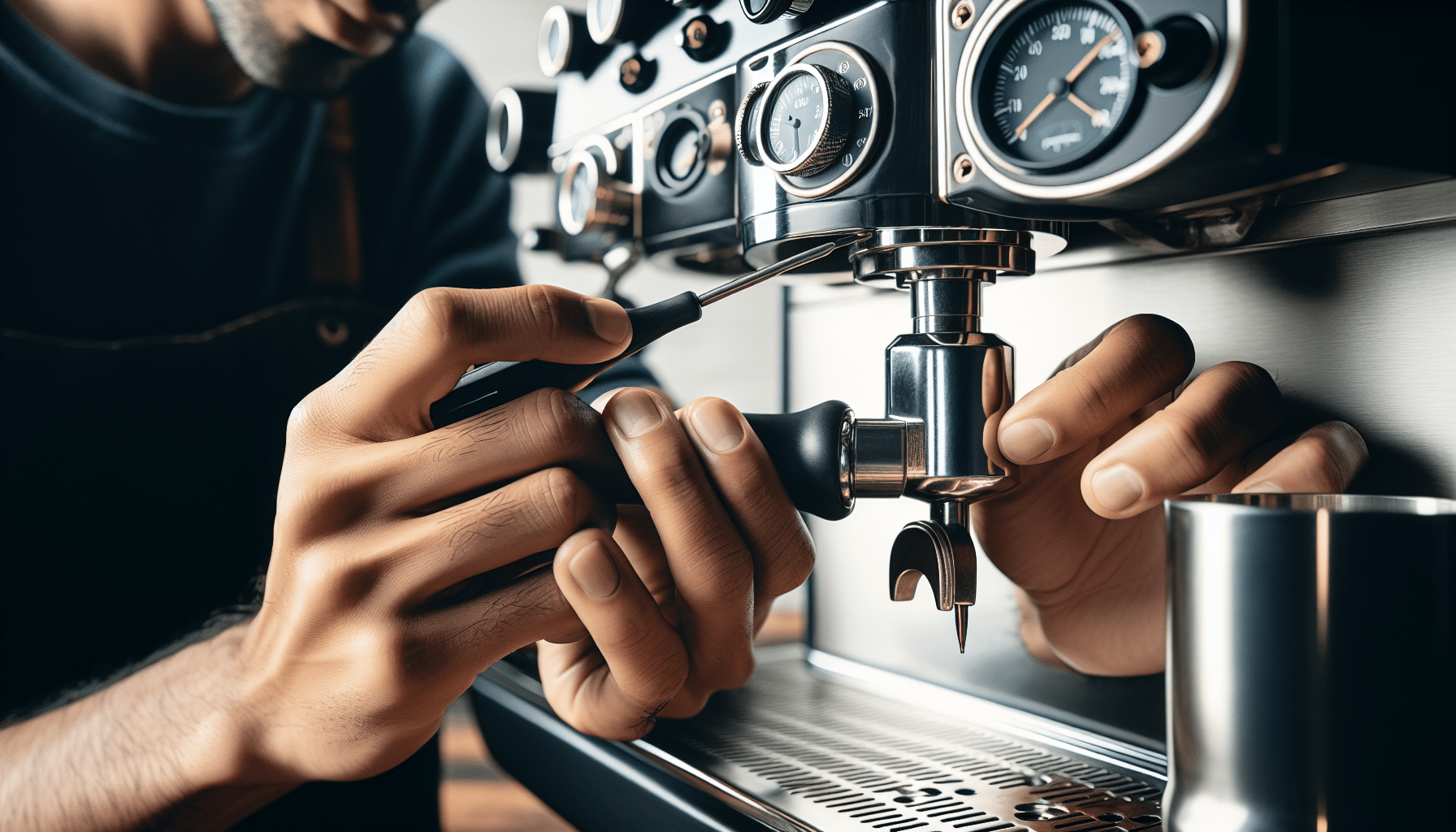Imagine a world where the aroma of freshly brewed coffee wafts through the air, enticing you with its rich and irresistible scent. Now picture yourself in control of the process, effortlessly creating the perfect cup of espresso with a semi-automatic espresso machine. Curious about how this remarkable contraption operates? Well, prepare to be amazed as we take a closer look at the inner workings of a semi-automatic espresso machine and unveil the secrets behind its ability to deliver truly exceptional coffee creations. Get ready to explore the fascinating world of espresso machines and uncover the magic that happens behind the scenes.
Overview of a Semi-Automatic Espresso Machine
If you’re someone who enjoys a good cup of espresso, you’ve probably thought about getting your own espresso machine. One type of espresso machine that you may come across is the semi-automatic espresso machine. In this article, we will take a comprehensive look at the components and basic operation of a semi-automatic espresso machine. By the end, you’ll have a good understanding of how this fascinating piece of machinery works.
Components of a Semi-Automatic Espresso Machine
To fully grasp the inner workings of a semi-automatic espresso machine, it’s essential to familiarize yourself with its key components. Let’s explore each one in detail.
Boiler
The boiler is the heart of the espresso machine, responsible for heating and controlling the water temperature. It is typically made of stainless steel or copper. The boiler’s primary role is to heat the water to the optimal temperature for extracting espresso. It also maintains a consistent temperature throughout the brewing process.
Pump
The pump in a semi-automatic espresso machine is responsible for creating the pressure required to extract espresso from the coffee grounds. It draws water from the boiler and forces it through the coffee, resulting in the rich, flavorful shot of espresso. The pump ensures a consistent pressure for extraction, which is crucial for achieving the desired taste profile.
Portafilter
The portafilter is the component that holds the coffee grounds during the extraction process. It attaches to the grouphead of the espresso machine and holds a filter basket where the coffee is placed. The portafilter’s handle makes it easy to insert and remove from the machine, allowing for convenient coffee preparation.
Grouphead
The grouphead is where the magic happens. It is the component that connects the portafilter to the espresso machine. The grouphead houses the brewing chamber, which receives hot water from the boiler and distributes it evenly over the coffee grounds. This distribution ensures that each particle of coffee is extracted uniformly and contributes to a balanced and flavorful shot.
Steam Wand
The steam wand is a crucial feature of a semi-automatic espresso machine, especially if you enjoy milk-based drinks like lattes and cappuccinos. It is responsible for steaming and frothing milk to create the desired texture. The steam wand releases hot steam, which is used to heat and froth the milk. With practice, you can become a master at achieving that perfect velvety microfoam.
Control Panel
The control panel provides the user interface for operating the espresso machine. It typically includes buttons, knobs, and displays that allow you to control various functions such as power, water temperature, and extraction time. The control panel makes it easy to adjust these settings to customize your espresso experience.
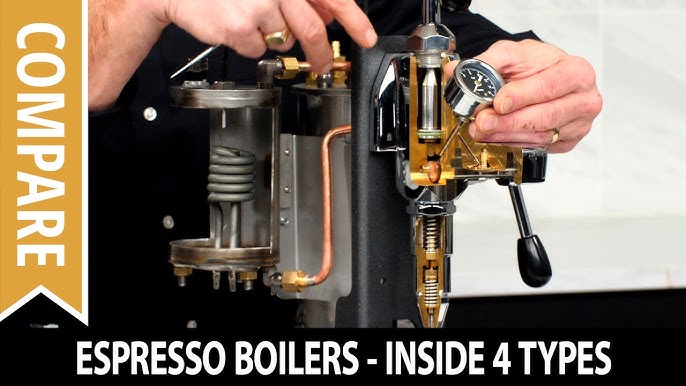
Basic Operation of a Semi-Automatic Espresso Machine
Now that we have a good understanding of the components, let’s dive into the basic operation of a semi-automatic espresso machine. By following these steps, you’ll be well on your way to brewing delicious espresso at home.
Filling the Water Tank
First and foremost, ensure that the water tank of your espresso machine is filled with fresh, filtered water. The water tank is usually located at the back or side of the machine and can be easily removed and refilled. It’s important to use clean water to ensure the best taste and prevent any mineral build-up inside the machine.
Preheating the Machine
Before brewing espresso, it’s crucial to preheat the espresso machine. This step ensures that the machine reaches the ideal brewing temperature, enhancing coffee extraction. Allow the machine to heat up for a few minutes after turning it on. Some machines have temperature indicators to let you know when it’s ready.
Grinding and Dosing the Coffee
For optimal flavor extraction, freshly ground coffee is essential. Use a burr grinder to grind your coffee beans to the desired grind size. Different espresso machines may require a specific grind size, so be sure to check the machine’s specifications. Once the coffee is ground, dose the appropriate amount into your portafilter’s filter basket.
Tamping the Coffee
Tamping is the process of compressing the coffee grounds evenly in the portafilter to ensure a consistent extraction. Use a tamper to apply firm and even pressure to the coffee grounds. A level, flat surface is important to achieve an even extraction. Aim for a tamped bed of coffee that is level and compact, but not too dense.
Attaching the Portafilter
Once your coffee is tamped, it’s time to attach the portafilter to the grouphead. Insert the portafilter into the grouphead and lock it in place. Ensure it is securely attached to prevent any leaks during the brewing process. As you insert the portafilter, be careful not to touch the hot surfaces to avoid burns.
Pulling the Shot
With the portafilter securely attached, it’s time to start the extraction process. Activate the extraction by pressing the appropriate button or lever on the machine’s control panel. The pump will engage, forcing hot water through the coffee grounds in the portafilter. The extraction process should take around 25 to 30 seconds, resulting in a flavorful shot of espresso.
Steaming Milk
If you’re craving a milk-based drink, you’ll want to use the steam wand to steam and froth the milk. Start by purging any condensed water from the wand, then place the wand into a pitcher of cold, fresh milk. Activate the steam function, and position the steam wand just below the surface of the milk. Angle the pitcher and begin introducing air into the milk to create that creamy and velvety texture.
Cleaning and Maintenance
Proper cleaning and maintenance are crucial to ensure the longevity and performance of your espresso machine. Regularly clean the grouphead, portafilter, and steam wand after each use. Additionally, descale the machine periodically to remove mineral deposits. Follow the manufacturer’s instructions for cleaning and maintenance to ensure optimal functioning.
Boiler
The boiler plays a crucial role in the operation of a semi-automatic espresso machine. Let’s take a closer look at its purpose, different types, and the importance of temperature control.
Purpose of the Boiler
The boiler serves as a reservoir for water and is responsible for heating it to the desired temperature. The heated water is then used for brewing espresso, generating steam, or distributing hot water for other purposes. The boiler provides a consistent and controlled source of hot water, ensuring optimal extraction and steam production.
Boiler Types
Semi-automatic espresso machines typically use either a single boiler or a double boiler system. Single boiler machines have a single boiler chamber for both brewing and steaming. This design requires time to switch between brewing and steaming, as the boiler needs to heat or cool sufficiently. Double boiler machines, on the other hand, have separate boilers for brewing and steaming, allowing simultaneous preparation of espresso and steamed milk.
Temperature Control
Temperature control is vital for achieving consistent, high-quality espresso. The boiler is equipped with a thermostat, which helps regulate the water temperature. Modern espresso machines often have sophisticated temperature control systems that allow users to adjust the temperature easily. Proper temperature control ensures that the coffee is brewed at the ideal temperature, resulting in a flavorful and balanced shot.

Pump
The pump mechanism is an essential component that creates the necessary pressure to extract espresso from the coffee grounds. Let’s explore its role, function, and the different types of pumps commonly found in semi-automatic espresso machines.
Role and Function of the Pump
The main purpose of the pump in a semi-automatic espresso machine is to generate the pressure required for the extraction process. It draws water from the boiler and delivers it to the coffee grounds in the portafilter at a consistent pressure. The pump’s role is to ensure that water is forced through the coffee grounds evenly and at the correct rate, allowing for optimal flavor extraction.
Pump Types
There are two primary types of pumps used in semi-automatic espresso machines: vibratory pumps and rotary pumps.
Vibratory pumps are commonly found in home espresso machines due to their compact size, affordability, and ease of use. These pumps use a vibrating diaphragm to generate pressure. Vibratory pumps are relatively quiet, reliable, and capable of producing the necessary pressure for espresso extraction.
Rotary pumps, on the other hand, are more commonly found in commercial or high-end espresso machines. These pumps use rotating gears or vanes to create pressure. Rotary pumps offer precise pressure control, making them ideal for espresso enthusiasts who desire more control over the extraction process. They are known for their durability and consistent performance.
Portafilter
The portafilter is an integral part of a semi-automatic espresso machine, serving as a vessel for holding the coffee grounds during the brewing process. Let’s delve into its definition, function, and the different types available.
Definition and Function of a Portafilter
A portafilter, also known as a filter handle or brew handle, is a handle-equipped component that holds the coffee grounds for brewing espresso. It attaches to the espresso machine’s grouphead and contains a filter basket where the coffee grounds are placed. The portafilter’s main function is to evenly distribute hot water over the coffee grounds, extracting the flavors and oils to produce a delicious shot of espresso.
Types of Portafilters
There are two main types of portafilters: pressurized and non-pressurized.
Pressurized portafilters are often found in entry-level or beginner-friendly espresso machines. They contain a built-in pressure valve that helps compensate for inconsistencies in grind size and tamping pressure. This design simplifies the brewing process and produces a more forgiving extraction, making it suitable for those new to home espresso brewing.
Non-pressurized portafilters require more skill and precision in grind size, tamping, and extraction. They do not have a pressure valve, thus relying on the barista’s technique to achieve optimal results. Non-pressurized portafilters are commonly used by experienced baristas and roasters who appreciate the control and flexibility they offer in creating the perfect espresso shot.
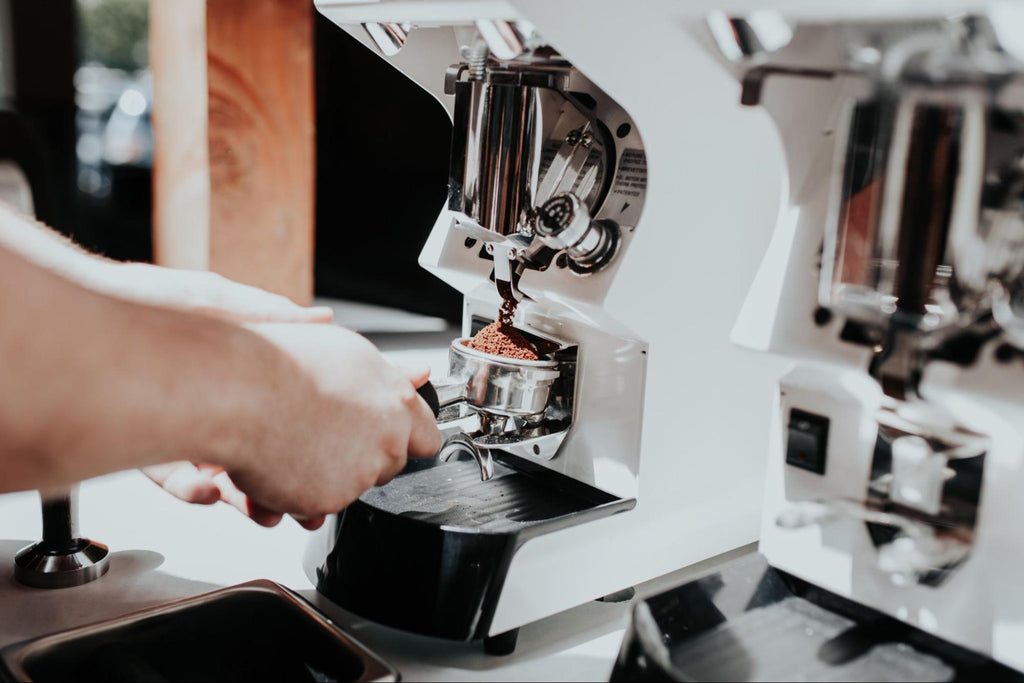
Grouphead
The grouphead of a semi-automatic espresso machine is an essential component that connects the portafilter to the machine. It plays a significant role in ensuring a consistent and even extraction. Let’s explore what the grouphead is and its specific functions.
What is a Grouphead?
The grouphead, also known as the brew head, is the part of the espresso machine that receives hot water from the boiler and distributes it evenly over the coffee grounds. It is the interface between the espresso machine and the portafilter. The grouphead ensures that each particle of coffee is saturated and extracted uniformly, resulting in a balanced and flavorful shot of espresso.
Functions of the Grouphead
The grouphead serves several critical functions during the espresso extraction process:
-
Pre-infusion: The grouphead allows for pre-infusion, which involves wetting the coffee grounds before applying pressure. Pre-infusion ensures an even saturation and helps release the carbon dioxide trapped within the coffee, allowing for a more uniform extraction.
-
Even distribution: By evenly distributing the water over the coffee grounds, the grouphead ensures that each particle of coffee is extracted uniformly. This consistency contributes to the taste and quality of the resulting espresso.
-
Temperature stability: The grouphead helps maintain a stable temperature during the extraction process. It ensures that the water remains at the proper brewing temperature, allowing for optimal flavor extraction.
-
Pressure control: The grouphead helps regulate the pressure applied to the coffee grounds during extraction. It ensures that the water is delivered at the correct pressure for the desired flavor profile.
Steam Wand
For those who enjoy milk-based drinks, the steam wand is an essential feature of a semi-automatic espresso machine. Let’s explore what the steam wand is, how it works, and how to effectively use it.
Introduction to the Steam Wand
The steam wand, also known as the steam arm or frothing wand, is a component of a semi-automatic espresso machine that enables the steaming and frothing of milk. It uses steam generated by the boiler to heat and froth the milk, creating the creamy texture desired in beverages like lattes and cappuccinos.
Using the Steam Wand
To use the steam wand effectively, follow these steps:
-
Purging: Before using the steam wand, it’s important to remove any condensed water by opening the steam valve briefly. This ensures that only dry hot steam is used for steaming and frothing.
-
Positioning: Place the steam wand into a pitcher of cold, fresh milk. Position the wand at an angle, just below the surface of the milk, to introduce the steam efficiently.
-
Introducing air: Slowly open the steam valve to release steam into the milk. Begin by introducing air into the milk by lowering the pitcher slightly while keeping the wand near the surface. This process helps create the desired amount of froth.
-
Steaming: As the milk expands and increases in temperature, submerge the wand further into the milk to continue heating and texturing. Keep the wand just below the surface to incorporate the steam into the milk evenly.
-
Monitoring: Pay close attention to the temperature and texture of the milk. Aim for a final temperature between 150°F to 155°F (65°C to 68°C) for ideal taste and texture. Remember that the milk will continue to heat even after the steam is turned off, so monitor carefully to avoid overheating.
-
Finishing: Once the desired temperature and texture are achieved, close the steam valve and remove the steam wand from the milk. Clean the wand with a damp cloth to prevent any milk residue from hardening.
With practice and experimentation, you’ll be able to achieve that perfect velvety microfoam to complement your espresso shots.

Control Panel
The control panel of a semi-automatic espresso machine provides a user-friendly interface for operating various functions of the machine. Let’s explore the functions typically found on a control panel and how to adjust settings to customize your espresso experience.
Control Panel Functions
Control panels may vary depending on the specific espresso machine model, but they typically offer the following functions:
-
Power: The power button allows you to turn the machine on and off. It provides quick and easy control over the machine’s overall power supply.
-
Brew buttons: These buttons activate the extraction process. Depending on the machine, there may be single shot and double shot buttons, allowing you to select the desired amount of espresso to be brewed.
-
Steam function: The steam function button or lever activates the steam wand, allowing you to froth and heat milk for milk-based beverages. It’s important to use this function carefully to avoid potential burns.
-
Hot water function: Some espresso machines have a separate button for dispensing hot water. This function is useful for making Americano or tea.
Adjusting Settings on the Control Panel
To adjust settings on the control panel, consult your espresso machine’s user manual for specific instructions. Typically, machines offer the ability to modify the following settings:
-
Water temperature: Some machines allow you to adjust the water temperature for brewing espresso. This can be useful for experimenting with different coffee beans or achieving optimal extraction according to your preferences.
-
Extraction time: By adjusting the timing parameters on the control panel, you can control the length of the extraction process. Longer extraction times may result in stronger flavors, while shorter times may produce milder shots.
-
Steam pressure: If your machine allows for steam pressure adjustment, you can fine-tune the steam output to control the speed and texture of the milk frothing process.
By taking advantage of these control panel settings, you can customize your espresso brewing experience and tailor it to your preferences.
Replacing Filters
To ensure optimal performance and maintain the quality of your espresso, it’s important to replace filters regularly. Let’s explore the lifespan of filters and how they contribute to enhancing water quality.
Filter Lifespan
Filters in a semi-automatic espresso machine typically need to be replaced periodically. Each machine may have specific recommendations, so check the manufacturer’s guidelines for your model. The frequency of replacement depends on factors such as water quality, usage, and maintenance. Regularly replacing filters helps maintain the machine’s performance and prevents any unwanted flavors or odors from tainting your espresso.
Water Quality Enhancement
Filters in espresso machines play a crucial role in enhancing water quality. They help remove impurities such as chlorine, minerals, and sediments that can affect the taste and aroma of your espresso. By improving the water quality, filters ensure a clean and pure base for brewing, allowing the coffee flavors to shine through.
To replace filters, consult your machine’s user manual for specific instructions. The process typically involves removing and replacing the old filter or cartridge with a new one. Be sure to follow the manufacturer’s guidelines to ensure proper installation and efficient filtration.
In conclusion, a semi-automatic espresso machine offers a convenient and rewarding way to brew espresso at home. By understanding its components and how it operates, you can fully appreciate the art and science behind a great cup of espresso. With practice and experimentation, you’ll be able to master the craft, impressing yourself and others with delicious, café-quality espresso right in your own kitchen.
